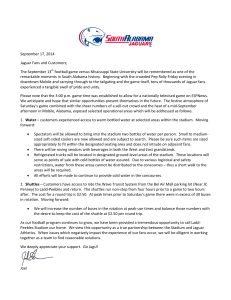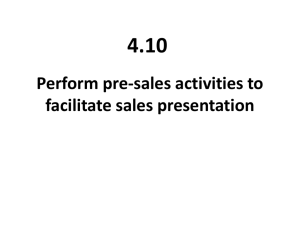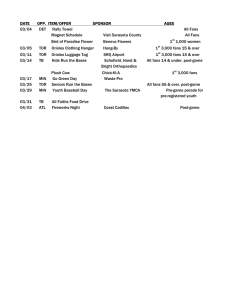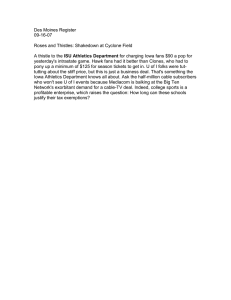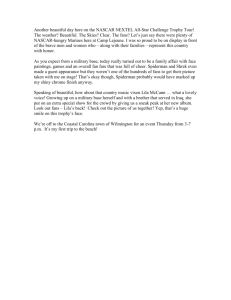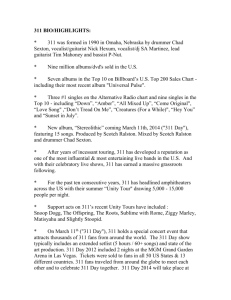Types of Deviant Behavior among Football Fans in Malaysia
advertisement
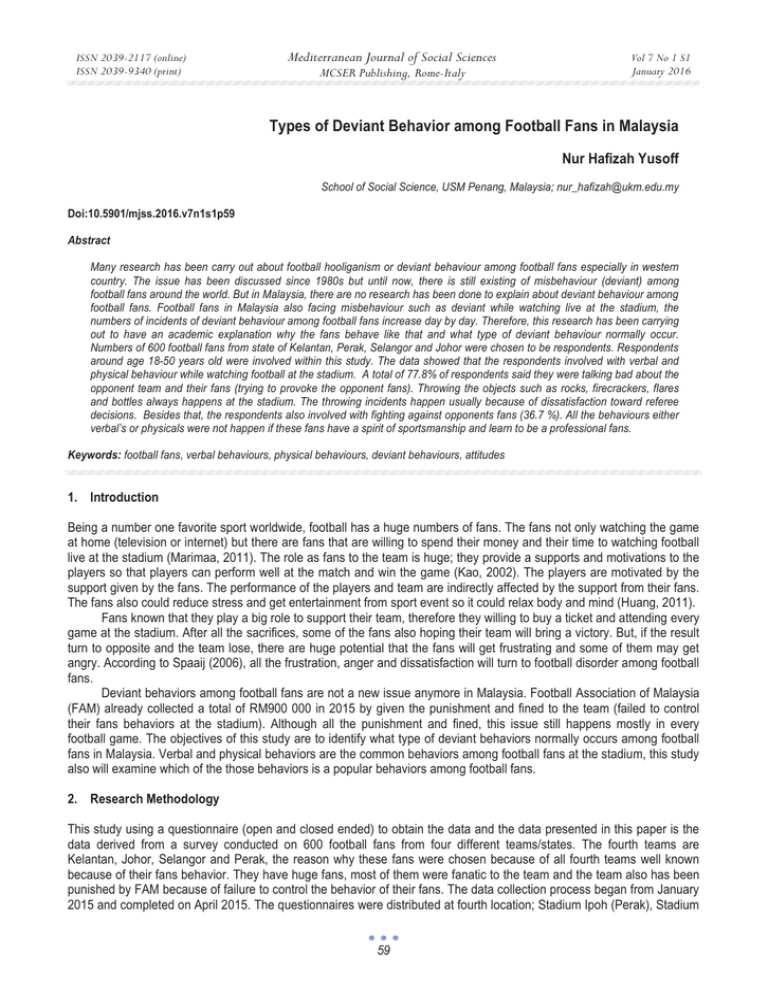
ISSN 2039-2117 (online) ISSN 2039-9340 (print) Mediterranean Journal of Social Sciences MCSER Publishing, Rome-Italy Vol 7 No 1 S1 January 2016 Types of Deviant Behavior among Football Fans in Malaysia Nur Hafizah Yusoff School of Social Science, USM Penang, Malaysia; nur_hafizah@ukm.edu.my Doi:10.5901/mjss.2016.v7n1s1p59 Abstract Many research has been carry out about football hooliganism or deviant behaviour among football fans especially in western country. The issue has been discussed since 1980s but until now, there is still existing of misbehaviour (deviant) among football fans around the world. But in Malaysia, there are no research has been done to explain about deviant behaviour among football fans. Football fans in Malaysia also facing misbehaviour such as deviant while watching live at the stadium, the numbers of incidents of deviant behaviour among football fans increase day by day. Therefore, this research has been carrying out to have an academic explanation why the fans behave like that and what type of deviant behaviour normally occur. Numbers of 600 football fans from state of Kelantan, Perak, Selangor and Johor were chosen to be respondents. Respondents around age 18-50 years old were involved within this study. The data showed that the respondents involved with verbal and physical behaviour while watching football at the stadium. A total of 77.8% of respondents said they were talking bad about the opponent team and their fans (trying to provoke the opponent fans). Throwing the objects such as rocks, firecrackers, flares and bottles always happens at the stadium. The throwing incidents happen usually because of dissatisfaction toward referee decisions. Besides that, the respondents also involved with fighting against opponents fans (36.7 %). All the behaviours either verbal’s or physicals were not happen if these fans have a spirit of sportsmanship and learn to be a professional fans. Keywords: football fans, verbal behaviours, physical behaviours, deviant behaviours, attitudes 1. Introduction Being a number one favorite sport worldwide, football has a huge numbers of fans. The fans not only watching the game at home (television or internet) but there are fans that are willing to spend their money and their time to watching football live at the stadium (Marimaa, 2011). The role as fans to the team is huge; they provide a supports and motivations to the players so that players can perform well at the match and win the game (Kao, 2002). The players are motivated by the support given by the fans. The performance of the players and team are indirectly affected by the support from their fans. The fans also could reduce stress and get entertainment from sport event so it could relax body and mind (Huang, 2011). Fans known that they play a big role to support their team, therefore they willing to buy a ticket and attending every game at the stadium. After all the sacrifices, some of the fans also hoping their team will bring a victory. But, if the result turn to opposite and the team lose, there are huge potential that the fans will get frustrating and some of them may get angry. According to Spaaij (2006), all the frustration, anger and dissatisfaction will turn to football disorder among football fans. Deviant behaviors among football fans are not a new issue anymore in Malaysia. Football Association of Malaysia (FAM) already collected a total of RM900 000 in 2015 by given the punishment and fined to the team (failed to control their fans behaviors at the stadium). Although all the punishment and fined, this issue still happens mostly in every football game. The objectives of this study are to identify what type of deviant behaviors normally occurs among football fans in Malaysia. Verbal and physical behaviors are the common behaviors among football fans at the stadium, this study also will examine which of the those behaviors is a popular behaviors among football fans. 2. Research Methodology This study using a questionnaire (open and closed ended) to obtain the data and the data presented in this paper is the data derived from a survey conducted on 600 football fans from four different teams/states. The fourth teams are Kelantan, Johor, Selangor and Perak, the reason why these fans were chosen because of all fourth teams well known because of their fans behavior. They have huge fans, most of them were fanatic to the team and the team also has been punished by FAM because of failure to control the behavior of their fans. The data collection process began from January 2015 and completed on April 2015. The questionnaires were distributed at fourth location; Stadium Ipoh (Perak), Stadium 59 ISSN 2039-2117 (online) ISSN 2039-9340 (print) Mediterranean Journal of Social Sciences Vol 7 No 1 S1 January 2016 MCSER Publishing, Rome-Italy Sultan Mohamed IV (Kelantan), Stadium Shah Alam (Selangor) and Stadium Tan Sri Dato Haji Hassan Yunus (Johor). Respondents of the study consisted of male and female football fans between aged 18 to 50 years old. Data from the survey was processed and analyzed using Statistical Package for Social Sciences (SPSS). The data was then presented via descriptive frequency to determine the frequency of occurrence. Besides that, the unstructured interview also has been done within officer from FAM and several leader of fans group to get additional information about types of deviant behaviors among football fans and the factors leading to those behaviors. 3. Findings and Discussion 3.1 Verbal behavior at the stadium Before discuss more about the behavior occur at the stadium, it is essential to know what are the respondents think about the environment at the stadium (watching live at the stadium). Majority of the respondents (92 percents) said that the environment at the stadium is chaotic and noise. There a lot of fans with a full of support to their team, wanting the team to win and some of them not ready to lose. Because of the tenses, it will derive football disorder to occur especially among fanatic fans. Some of the respondents said that, the chaotic and noise while watching at live at the stadium are normal because of the nature of watching football; full of shouting, yelling, screaming and all of that actually give more excitement and enjoyment. While other respondents added, there is no wrong if the fans want to have more fun while watching the game as long as they’re not breaking the rules. This is because it is this kind of atmosphere which would potentially warm up another match. There are two types of deviant behaviors normally occur at the stadium which are verbal and physical. Those two types of deviant behaviors happen because of lack of sportsmanship among football fans in Malaysia (cannot accept the loss of their team and easily get angry and frustrated of the results). Table 1.1: Verbal behavior at the stadium Verbal behavior Talking / Conversing Shouting Shouting team slogans Singing team songs Mocking opposing team/players Voicing dissatisfaction against match officials Provoking supporters of opposing team N=600 Frequency 578 567 572 571 467 462 371 Percentage (%) 96.3 94.5 95.3 95.2 77.8 77.0 61.8 Source: Field Study 2015 Table 1.1 shows the kinds of verbal behavior that were displayed by respondents in the stadium. Talking with other fans is the most verbal behavior occur (96.3%), the fans tend to talking about the tactical, the player and the game while watching it. Surprisingly if the respondents came alone to the stadium, they also talking and commenting about the game with other fans sitting next to them. Other verbal behavior normally occurs are shouting team slogans (95.3%) and singing team songs (95.2%). These kinds of behaviors actually trying to motivate the players so that they more confident and will perform well. Actions such as mocking players and the opposing team (77.8%), provoking the opponent fans (61.8%) and voicing their discontent against match officials (77.0%) had also been committed by the respondents. Provocation such as mocking the opposing team, shouting vulgar and obscene words were among some of the actions committed. And for them, these behaviors were normal and did not contravene rules. However, for the rest of the respondents, even though they did not commit such acts, they claimed that they had personally witnessed situations of provocation and mocking of the opposing team while in the stadium. The same goes for voicing grievances against the decisions of match officials, especially the referee and the linesmen. Cursing is often made out against match officials if respondents were not satisfied with the decision of the match officials or considered a decision made by the match officials as being biased. 60 ISSN 2039-2117 (online) ISSN 2039-9340 (print) 3.2 Mediterranean Journal of Social Sciences Vol 7 No 1 S1 January 2016 MCSER Publishing, Rome-Italy Physical behavior at the stadium Some of the researcher said crowd violence related of direct or indirect acts of physical violence by sport spectators, at or away from sports arena, that result in injury to person or damage to property (Young 2000). Well known as ‘hooliganism’, especially at Europe country, this issue of violence among football spectators already been discuss from 1980s (Kerr 1994). Fighting with opponent fans, damage property and throwing objects are the physical behavior normally occurs within hooliganism. They also known as a fanatic fan to the team and have a sense of belonging within their team. Although in Malaysia, physical behavior at the stadium also happens in every matches but this situation is not worse compare to the European country. Rarely can we see the fighting among the fans but it does happen several times. If this issue does not tackle in early stage, Malaysia also will face of hooliganism phenomena in future. Football fans in Malaysia nowadays are more brave, bold and fanatic to their team. Table 1.2 shows the kinds of physical behavior that are often displayed by respondents when they are in the stadium. A total of 304 respondents admitted that they had damaged public property such as chairs and even toilets in the stadium. Reason they doing that were because they got frustrated of loses the game. While 38.2 percent of the respondents also involved in incidents of throwing objects (drink bottles, garbage, coins) into the field. According to the respondents, the behavior was driven by outrage against the decision of match officials which were deemed to be biased. These respondents tend to blame everyone especially the referee if their team loses the battle. FAM already listed a few forbidden objects such as drinking bottles, rocks, sticks, firecrackers and lasers and fans did not allow bringing all those items into the stadium. Security measures have been taken especially at the entrance to the stadium, but there are still supporters who successfully brought in all the forbidden items into the stadium. This was proven as there were respondents who stated that they had lit and thrown firecrackers (11.5% of respondents) while watching football matches. This situation showed that the security control does not working very well and perhaps the control not been done in holistic way. Table 1.2: Physical behavior at the stadium Physical behavior Damaging public property Throwing objects into the middle of the field Lighting up and throwing firecrackers Lighting flares Fighting Showing obscene gestures Frequency 304 229 69 62 220 408 % 50.7 38.2 11.5 10.3 36.7 68.0 Source: Field study 2015 Similarly, with the case of the flares, whereby there were respondents (62 of respondents) admitted that they lighted flares as an indication in celebrating the victory of their team. According to Spaijj (2006), a celebratory violence is quite common within spectators especially when they want to celebrate something (goals, penalty kick and winning the game). A total of 220 of respondents were involved in fighting with supporters of opposing teams. Fighting occurred as a result of severe provocation that was not well-received by the supporters. It started with a mocking episode, followed by the throwing of objects and finally ends with a fight. Fights usually involved more than one supporter and the respondents were lucky as they were not detained by the authorities due to the factor of too many supporters which made it difficult to make an arrest. Fighting also happen between fans against police officers especially when the fans want to avoid from get arrested. According to the respondents, there were indeed many cases of fighting which occurred between supporters in the stadium, especially involving fanatic supporters. However, not many could be arrested or broadcasted in the mass media. Showing obscene gestures also one of the physical behavior displayed by the respondents. A number of 408 respondents showed lewd gestures to supporters of the opposing team and also to match officials. This occurred instigated by the factor of frustration due to the defeat of their favorite team and to show dissatisfaction towards the match officials. The referee always had been a target man especially when the referee gave the red card, yellow card and penalty kick to opponent team. In addition, the sense of frustration and dissatisfaction were also directed towards the supporters of the opposing team especially when they celebrated their victory in a way which could trigger anger in the losing team (Coackley, 2009). 61 ISSN 2039-2117 (online) ISSN 2039-9340 (print) Mediterranean Journal of Social Sciences MCSER Publishing, Rome-Italy Vol 7 No 1 S1 January 2016 4. Conclusion Football is one of the most popular sports around the world. Watching football live at the stadium is more exciting and more happiness rather than sitting alone in front of television. That is why many of football fans willing to invest some money to buy a ticket just to make sure they have an opportunity to watching a live game. Normally the number of fans turn up at the stadium is thousands of fans and there is no guarantee that all the fans will obey the rules and norms provide by the authorities. The vast numbers of fans also being a challenge to the security officers to controlling the fans behaviors. Issue of deviant behaviors among football fans never will solved if the fans itself doesn’t want to change their minds and attitudes. They should be more responsibility for their attitudes and behavior. To be fans, they actually need to control their attitudes and the most important is their emotions so that it will not affect their team as well. Sportsmanship spirit supposes to be the main element in every fan so that they can accept the fact of winning or losing of their team. References Coakley, J. (2009). Sports in society: Issues and controversies. New York: McGraw-Hill. Dunning, E. (2000). Towards a Sociological Understanding of Football Hooliganism as a World Phenomenon. European Journal on Criminal Policy and Research. (2), 141–62. Fikret. R & Bilal. C. (2005). Agressiveness behaviours of soccer spectators and prevention of these behaviours. Firat University Journal of Social Science. (15), 279-287. Huang, M. J. (2011). Determinant factors and satisfaction of spectators at the selecting national table tennis team competition in Taiwan. Paper presented at The 12th ITTF Sports Science Congress, Rotterdam, Netherlands. Kao, C.H. (2002). Recreational sport business management. Zhi-xuan, Taipei. Kelly, J. R. (1996). Leisure. Boston: Allyn & Bacon. Kerr, J. H. (1994). Understanding soccer hooliganism. Buckingham: Open University Press. King, A. (2001) ‘Violent pasts: collective memory and football hooliganism’. Sociological Review, (49), 89-97. Macri. K. J. (2012). Not just a game: sport and society in the United States. The International Student Journal. Vol 4(8). Marimaa. K. (2011). The many faces of fanaticism. ENDC Proceedings,Volume 14. 29-55. Spaaij, R. (2006). Aspects of hooligan violence: A reappraisal of sociological research into football hooliganism. ASSR Working Paper Series, No. 06/02. Young. K. 2002. From sport violence to sport crime: aspects of violence, law and gender in the sport process, in M. Messner and S. BallRokeach (eds), Paradoxes of youth and sport. New York: Sunny Press. 62

